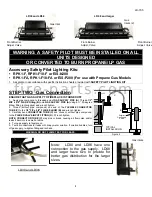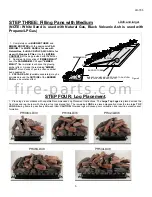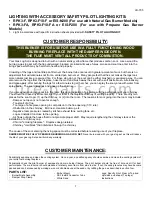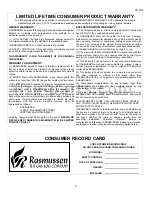
LD-705
7
LIGHTING WITH ACCESSORY SAFETY PILOT LIGHTING KITS:
• RPK3-F, RPK3-F10-F or EIS-N200 (For use with Natural Gas Burner Models)
• RPK3-FA, RPK3-F10-FA or EIS-P200 (For use with Propane Gas Burner
Models)
1. Light in accordance with specific instruction sheets provided with
SAFETY PILOT LIGHTING KIT
.
CUSTOMER RESPONSIBILITY:
THIS BURNER IS FOR USE FOR USE IN A FULLY FUNCTIONING WOOD
BURNING FIREPLACE WITH THE DAMPER WIDE OPEN.
THE FLUE MUST VENT ALL PRODUCTS OF COMBUSTION.
.
Your Gas Log Set is designed to burn with a natural smoky yellow flame that produces carbon soot. Like a wood fire,
burning a gas log set with the flue undersized, blocked or closed will cause fumes, smoke and soot toe enter into the
living space, which may be harmful to health and property.
Crowding of the logs and too little pan filler over the burner tube can result in greater amounts of soot, but there is no
adjustment that will eliminate soot from a vented pan burner set. Many people feel that the soot makes the logs look
more natural, just like a real wood fire. For those who do not, the soot can be either brushed or vacuumed away. You can
also remove the logs from the fireplace, hose them off and brush away the soot with a soft bristle brush. Alternatively,
and more easily, after burning the logs for a few minutes to get them hot, you can spray the sooty area with water from
spray bottle. The soot dislodges and goes up the chimney.
If you are experiencing any soot into the room, this is an indication of problems with the performance of your chimney.
You should not have any soot enter into in your room if the fireplace chimney is venting properly. There are only two
places for the soot to go: (1) up the chimney, or (2) into the room. The reasons for soot going into the room may include:
- Damper not open or not open far enough.
- Too small of a flue.
- Too large of a fireplace opening in comparison to the flue opening (1/10 rule).
- Obstruction in the chimney. Bird nest, creosote build-up, etc.
- Negative room pressure created by kitchen exhaust fans, ceiling fans, etc.
- Log set installed too close to the opening.
- Air flows outside the house that do not promote proper draft. May require lengthening the chimney stack or the
installation of a chimney cap.
- Chronic "smoking fireplace". Fireplace design related.
- Chimney "cold block" that inhibits air flow up the chimney.
The cause of the soot entering the living space must be corrected before resuming use of your fireplace.
DAMPER MUST BE FULLY OPEN WHEN BURNING A GAS LOG SET.
Never burn wood with your gas log set as this will reduce
the life of your gas Log Set and will void any warranty.
CUSTOMER MAINTENANCE:
Periodically examine and clean the venting system. Once a year, a qualified agency should examine and clean the venting system of
your solid fuel burning fireplace.
Periodically check the pilot burner (if equipped) and main burner flames. The pilot burner should be free of lint and dirt for best
performance. The main burner should produce a relatively even flame from side to side. If not, the sand-granules may have become
packed and can be loosened by working a wire or knife blade under the sand or by refilling the pan as described in section four.
PARTS LIST:
- Burner/Grate
Assembly
- Damper Stop Clamp
- Ember
Magic
- SS Flexible Connector Tube
- White Sand
- Logs: Specify Front, Rear or Top and
style/size and shape (Top logs).
- Instructions
f i r e - p a r t s . c o m


























